Iliad
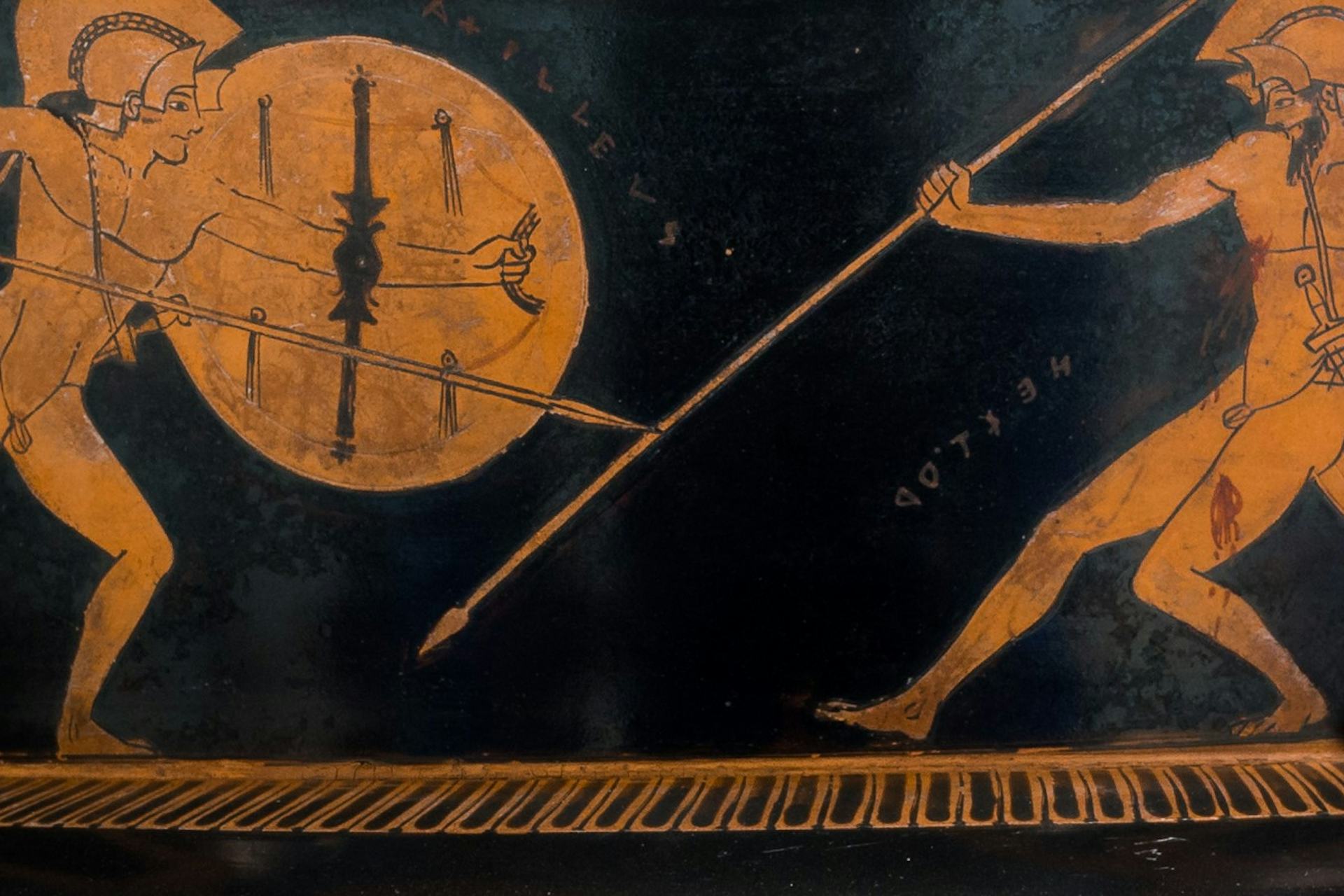
Neck of Attic red-figure volute-krater (mixing bowl) showing Achilles (left) fighting Hector (right) by the Berlin Painter (ca. 490 BCE)
British Museum, London / ArchaiOptixCC BY-SA 4.0Overview
The Iliad is one of the earliest, if not the earliest, surviving work of ancient Greek literature. An epic poem made up of 24 books, it was probably composed around 750–700 BCE. The Iliad, together with the Odyssey, was traditionally said to have been authored by Homer, an obscure figure about whom nothing is known.
The Iliad is set during the ninth year of the Trojan War, fought between the city of Troy and a coalition of cities in Greece inhabited by the “Achaeans.” The poem describes not the whole war but rather the consequences of a quarrel between Achilles, the greatest of the Achaean heroes, and Agamemnon, the commander-in-chief of the Achaean army—a quarrel that leads to suffering and death on both the Greek and the Trojan side. Today, the Iliad continues to be regarded as a foundational work of Western literature, exerting a dominating influence on scholarship, the arts, and pop culture.
Title
The title “Iliad” (Greek Ἰλιάς, translit. Ilias) is a feminine adjective meaning “Ilian” or “of Ilium” (“Ilium” being another name for Troy). We can imagine the full title of the poem as being Ἰλιάς ποίησις (Ilias poiēsis), that is, “poem of Ilium.”
Pronunciation
English
Greek
Iliad Ἰλιάς (translit. Ilias) Phonetic
IPA
[IL-ee-uhd] /ˈɪl i əd/
Author
We know nothing (possibly less than nothing) about Homer, the name traditionally given to the author of the Iliad and the Odyssey.
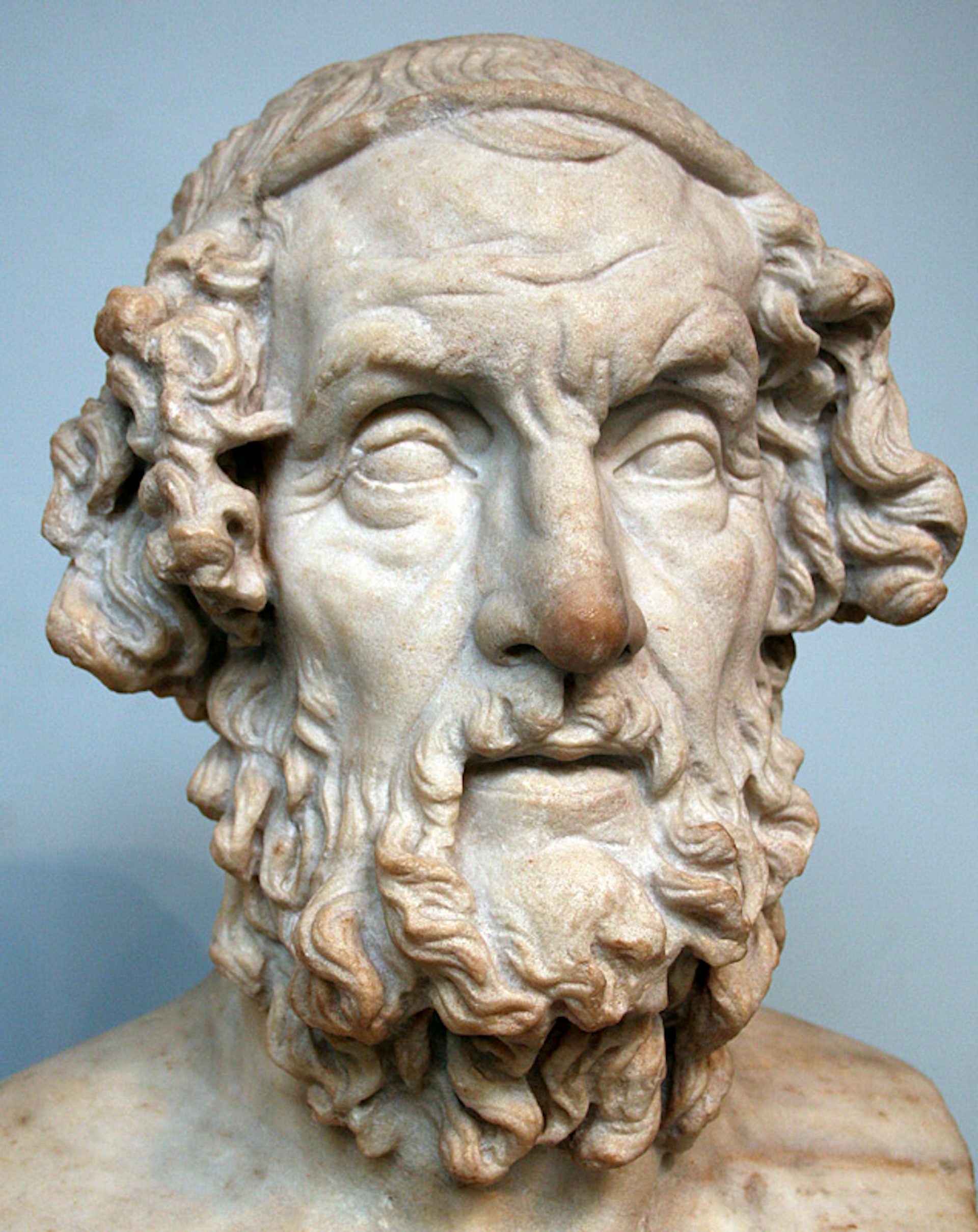
Bust of Homer. Roman copy of Hellenistic Greek original from the 2nd century BCE. From Baiae, Italy.
British MuseumPublic DomainA handful of ancient biographies of Homer (called “Lives”) were produced in antiquity. These made various claims about Homer, including that he was blind, that he was born on the Aegean island of Chios, that he was a wandering singer, and that he died on the island of Ios after being stumped by a riddle which some fisherman had posed to him. We have no reason, however, to believe that any of these things are true.
Today, most scholars agree that the Iliad and the Odyssey were composed between 750–700 BCE, meaning that Homer must have lived around that time. But many details surrounding the authorship and composition of Homer's poems remain fuzzy. Today, most scholars agree that a careful study of the language of the poems—especially their use of repeated words or phrases called formulae—demonstrated that the Iliad and Odyssey had been composed orally before they were written down.
Finally, though scholars today continue to refer to both Iliad and the Odyssey as “Homeric poems,” it is almost universally agreed that the two poems were not written by the same author (the Iliad is now regarded as the earlier of the two). In other words, the two “Homeric poems” were probably not by the same “Homer.” Many other poems were also attributed to Homer in antiquity (including the Homeric Hymns, the Epic Cycle, the Margites, and the Battle of Frogs and Mice), but these are now regarded as considerably later works (and, with the exception of the Homeric Hymns, they have not survived).
Mythological Context
Mythology
At the heart of the Iliad is the myth of the Trojan War. This was one of the most familiar myths of the ancient Greek world. It described a great struggle between the kings and heroes of Greece (often known collectively as the “Achaeans,” especially in Homer) and the powerful city of Troy or Ilium, located on the northwestern tip of modern Turkey.
The mythology of the Trojan War contained numerous individual episodes spanning many years. Usually, the story began with the Trojan prince Paris, fated to be the ruin of Troy. Following the so-called “Judgment of Paris,” this Paris carries off Helen from her home in Sparta and her Achaean husband Menelaus. The Achaean kings, led by Menelaus’ brother Agamemnon, put together an enormous army to sail to Troy and retrieve Helen. This sparks the Trojan War, which lasts ten years. Many heroes fall on both sides: Achaeans such as Patroclus, Achilles, and Ajax the Greater and Trojans such as Hector and, eventually, Paris himself. The war finally ends when the cunning Achaean king Odysseus thinks up the trick of the Trojan Horse. Troy is sacked and the Achaeans sail home. The colorful homecomings of the Achaean leaders can also be considered part of the mythology of the Trojan War.
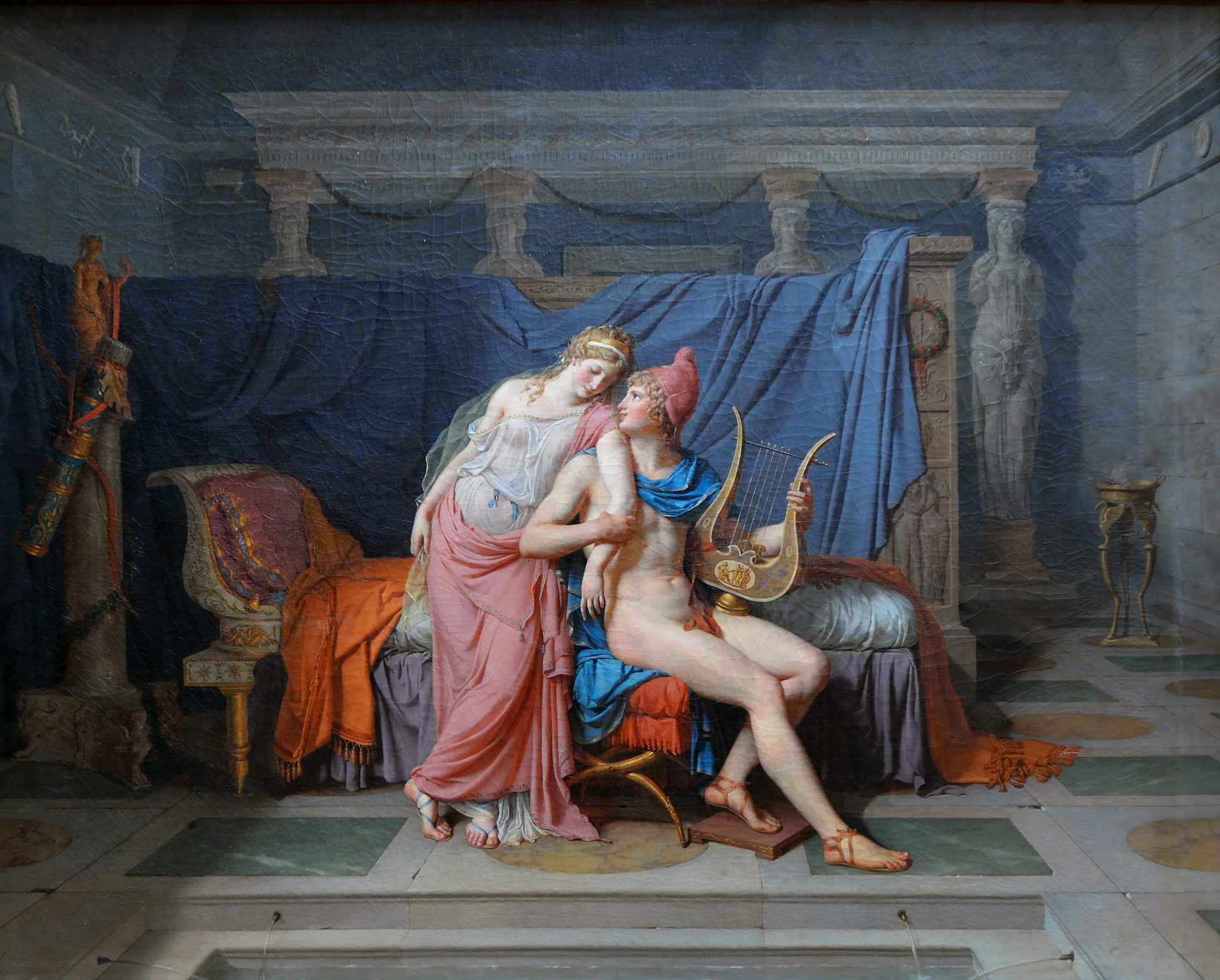
Paris and Helen by Jacques-Louis David (1788)
Louvre Museum, ParisPublic DomainSources
Although Homer’s Iliad and Odyssey are probably the best-known account of the Trojan War myth, they were hardly the only ones. In fact, Homer’s epics do not narrate the whole war: the Iliad only covers a period of several weeks from the ninth year of the war while the Odyssey covers the return of the hero Odysseus to Ithaca after the end of the war.
Other episodes from the myth were narrated in other epics, which together with the Homeric epics formed what is collectively known as the “Trojan Cycle,” though these unfortunately have not survived. The myth of the Trojan War was also popular among lyric poets, tragedians, visual artists, and Roman authors.
Significance
For the ancient Greeks, the Trojan War was an important historical landmark. After all, the ancient Greeks did not distinguish as we do between their “myths” and their “history:” to them, the Trojan War was as real as the Battle of Marathon.[1] The Trojan War represented the end of a storied period of the past sometimes known as the “Age of Heroes.” This was the period when great figures such as Perseus, Heracles, and the Argonauts were thought to have lived. The warriors who fought at Troy were the last of these larger-than-life heroes.[2]
Some ancient writers thus saw the Trojan War as the event that separated myth from history, or even as the very first truly “historical” event. Others even established the exact date of the Trojan War (the most influential of these “calculations” was carried out by Eratosthenes, who concluded that Troy fell in 1184/1183 BCE).[3] Many Greeks traced their ancestry to the heroes who had fought at Troy. The Trojan War was thus central to the Greeks’ conception of their past and their cultural identity.
Historicity
Today, historians continue to debate the historicity of the Iliad and the myth of the Trojan War. It is not impossible that the myth preserves a historical memory of a war fought during the Bronze Age, during the Mycenaean Period of Greek history (ca. 1600–1050 BCE).
Archaeologists have uncovered the remains of what was probably the city of ancient Troy, and some layers of the city (including the one belonging to the period when the mythical Trojan War would have taken place) showing signs of having been conquered and burned by an invading army. The Iliad itself also contains some details that fit better the conditions of the Bronze Age than the conditions of the Archaic Period, when Homer would have been writing (for example, the supremacy of Mycenae, references to boar-tusk helmets, etc.).
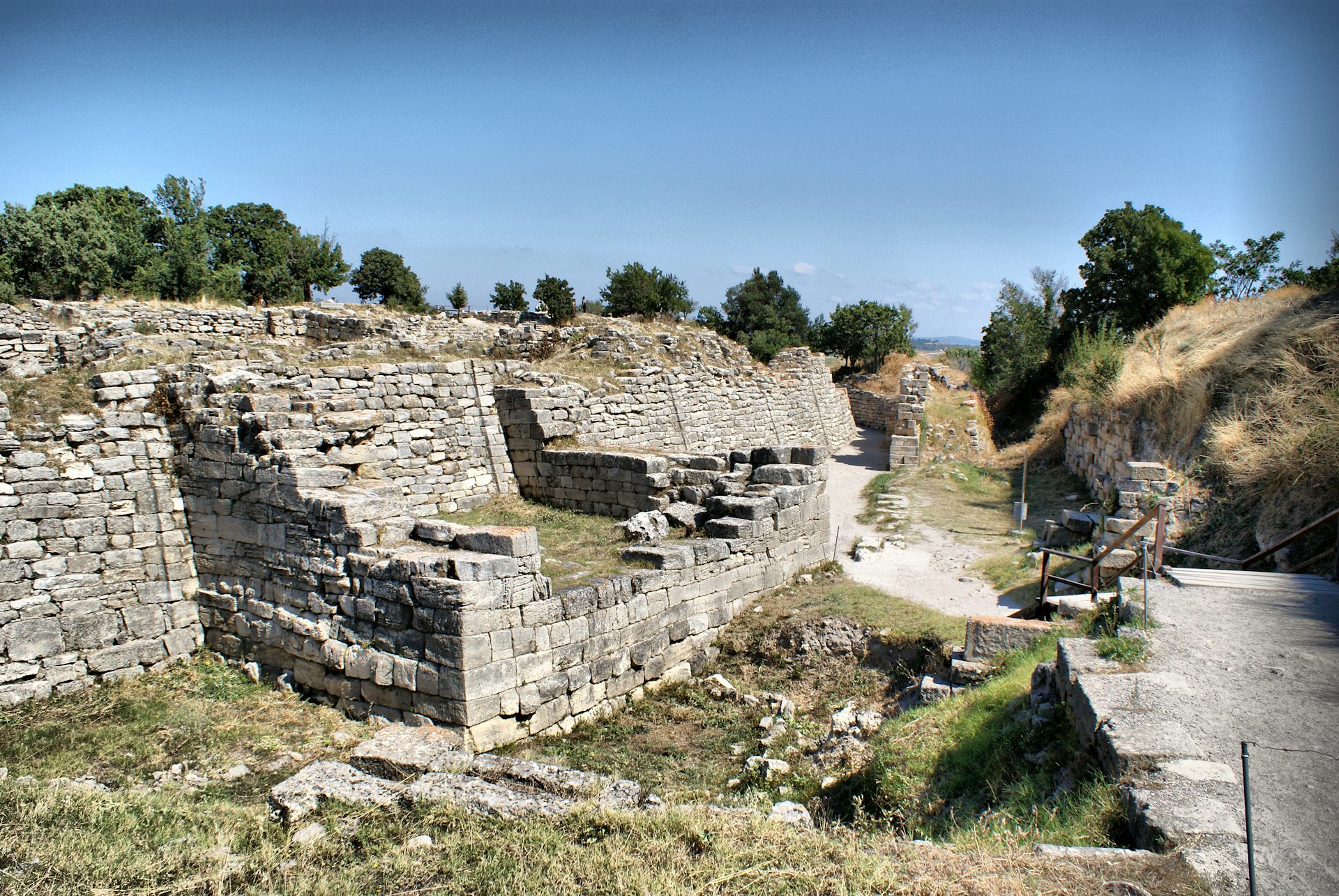
The ruins of ancient Troy in modern Hisarlik, Turkey
David SpenderCC BY 2.0Whatever kernel of historical truth there may be to the Trojan War, it has obviously been embellished with many mythical elements: fantastic stories about superhuman heroes, divine beings, and so on.
Synopsis
The Quarrel (Books 1–9)
The Iliad begins in Book 1 by outlining the origins of a fateful quarrel within the Achaean camp between Achilles, the greatest hero of his time, and Agamemnon, the army’s commander-in-chief. Agamemnon refuses to release his slave-girl Chriseis to her father, the Trojan priest Chryses, who asks Apollo to punish the Achaeans with a terrible plague. Agamemnon is finally forced to return the girl but takes Achilles’ slave-girl Briseis as compensation, causing Achilles to fly into a rage and withdraw from the war.
Achilles then has his mother Thetis, a sea goddess, ask Zeus to cause the Trojans to get the upper hand in the fighting so that the Achaeans realize how much they need him.
Book 2 begins when Zeus sends a deceptive dream to Agamemnon, setting off a chain of events that nearly ends in an Achaean retreat from Troy. After the retreat is stopped by Odysseus, the poet catalogues in detail first the separate contingents of the Achaeans army along with their leaders, kingdoms, and the total of their ships (the so-called “Catalogue of Ships”) and then the contingents of the Trojan army and their allies (the “Catalogue of Trojans”).
In Book 3, the Achaeans and Trojans agree to a truce so that Helen’s Trojan lover Paris and her Achaean husband Menelaus can settle the war in single combat. But when Menelaus gains the upper hand Paris is rescued and spirited back into Troy by his patron goddess Aphrodite. Then, in Book 4, the goddesses Hera and Athena—the chief divine enemies of the Trojans—cause the Trojans to break the truce; battle erupts.
Book 5 describes the glorious deeds carried out in battle by the Achaean hero Diomedes (a trope called an aristeia). In Book 6, Hector, a Trojan prince and the commander of the Trojan forces, goes to Troy to ensure that the women are praying and making offerings to the gods. While there, he speaks with his wife Andromache and his son Astyanax. He also finds Paris and orders him to return to battle.

The Combats of Diomedes by Jacques-Louis David (1776)
Wikimedia CommonsPublic DomainBook 7 describes the single combat between Hector and the Achaean hero Ajax the Greater, which ends in a draw. Another truce is called for both sides to bury their dead, and the Achaeans build a wall around their camp.
In Book 8, Zeus forbids the gods from interfering in the conflict between the Achaeans and Trojans, and the Trojans gain the upper hand and push the Achaeans back. Agamemnon, becoming desperate, sends Odysseus, Ajax the Greater, and Phoenix to Achilles in Book 9, offering him lavish gifts if he will return to the fighting. The proud Achilles refuses.
The Trials of the Achaeans (Books 10–18)
In Book 10, set during the same night as Book 9, Odysseus and Diomedes set out to spy on the Trojans, killing a Trojan spy named Dolon as well as a contingent of Trojan allies led by the Thracian king Rhesus (an episode known as the “Doloneia”).
In the morning, another battle begins (Book 11). The Achaean heroes Agamemnon, Diomedes, and Odysseus are all wounded. Nestor, the king of Pylos, asks Achilles’ best friend Patroclus to persuade Achilles to return to the fighting to help the Achaeans.
In Books 12 and 13, the battle continues to go badly for the Achaeans, with the Trojans breaking into the Achaean camp (Book 12) and slaughtering many Achaeans, despite the bravery of Ajax the Greater and the aid of the god Poseidon (Book 13).
In Book 14, Hera distracts Zeus so that Athena and Poseidon can help the Achaeans. But the tide turns back in favor of the Trojans when Zeus awakes in Book 15. The Trojans begin burning the Achaean ships.
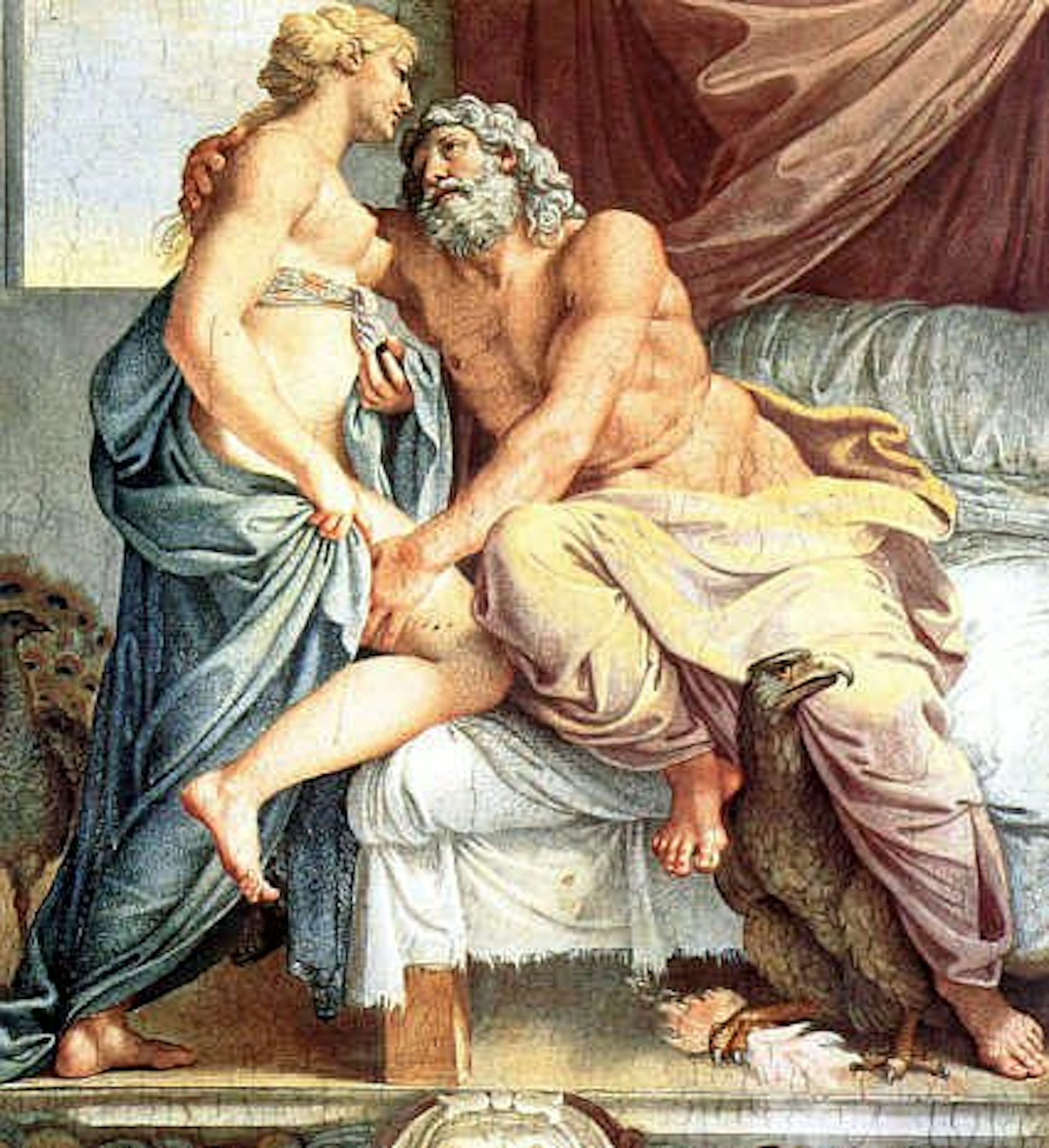
Jupiter and Juno by Annibale Carracci (late sixteenth century)
Wikimedia CommonsPublic DomainPatroclus is not able to convince Achilles to come to the Achaeans’ aid, but Achilles does agree to let Patroclus wear his armor into battle and lead out his men, the fearsome Myrmidons, against the Trojans (Book 16). Patroclus manages to drive the Trojans away from the Achaean camp before he is killed by Hector.
A battle breaks out over the body of Patroclus (Book 17). Achilles vows to avenge his friend’s death and his mother Thetis asks the smith-god Hephaestus to fashion a splendid new suit of armor for him (Book 18).
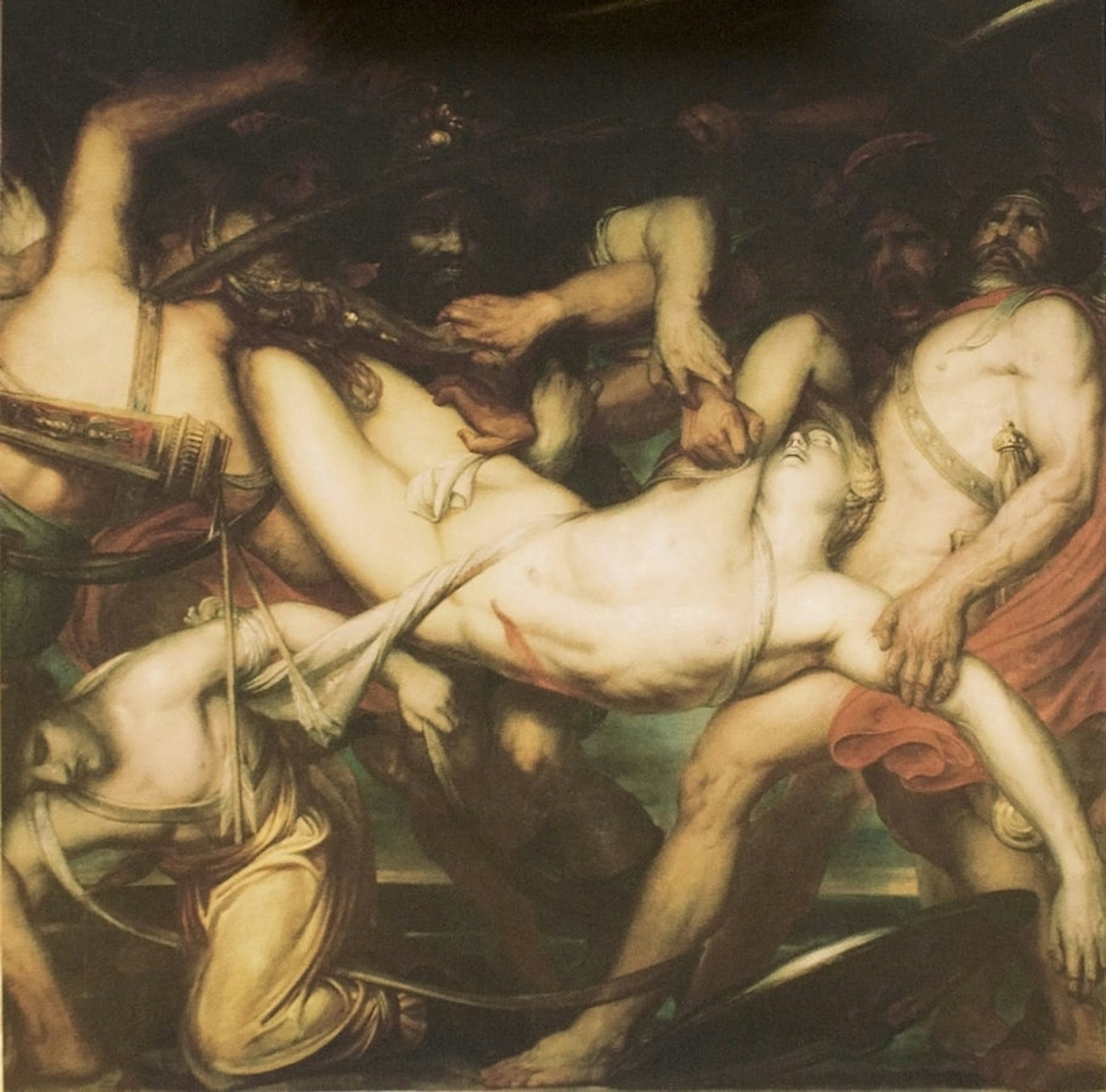
The Greeks and Trojans fighting for the Body of Patroclus by Antoine Wiertz (1836)
Antoine Wiertz Museum, IxellesPublic DomainThe Return of Achilles (Books 19–24)
Achilles and Agamemnon are reconciled and Achilles returns to battle so that he can kill Hector and avenge Patroclus (Book 19). Achilles goes on a rampage, killing many Trojans (Book 20) and even fighting the River Scamander and Apollo (Book 21).
In Book 22, the Trojans retreat behind their walls but Hector remains outside to face Achilles. After a brief fight, Achilles slays Hector. He then dishonors his corpse by dragging it behind his chariot and taking it back to his camp.
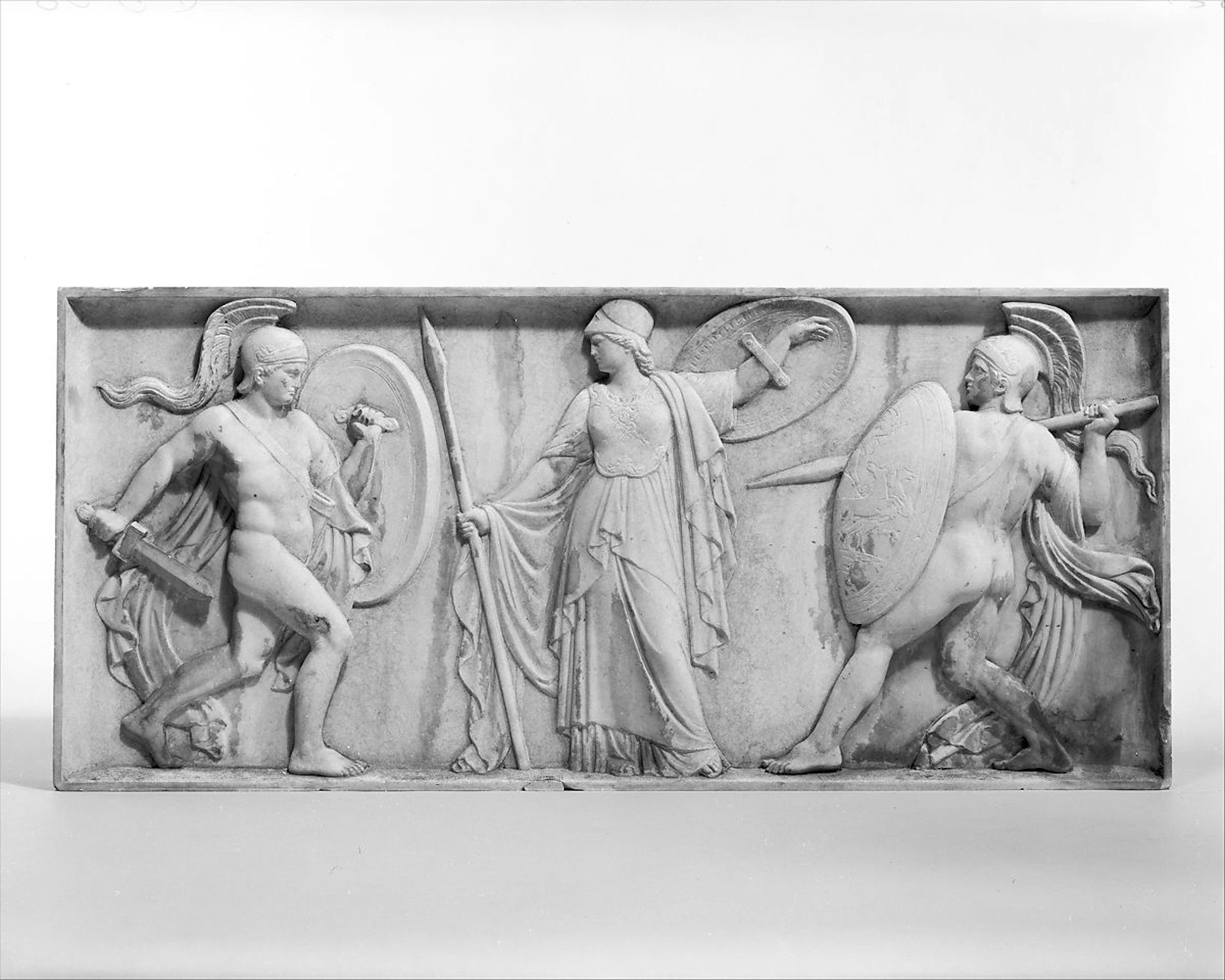
Marble decorative panel representing Achilles about to kill Hector as Athena stands between them by Giovanni Maria Benzoni (19th century)
The Metropolitan Museum of ArtPublic DomainWith Hector dead, Achilles holds a lavish funeral for Patroclus, complete with contests worthy of heroes (Book 23). In the final book of the Iliad (Book 24), the Trojan king Priam enters the Achaean camp to beg Achilles to return the body of his son Hector. Achilles pities Priam and gives him the body. Hector is given a great funeral at Troy.
Style and Composition
The Iliad is generally believed to have been composed before the Odyssey, the other epic usually regarded as “Homeric.” Like the Odyssey, the Iliad typifies the basic conventions of early Greek epic poetry, employing dactylic hexameter and the elevated and artificial linguistic diction that does not appear to have corresponded exactly to any spoken dialect of ancient Greek. These epics also sport many notable stylistic elements such as elaborate speeches and similes.
The Iliad is widely regarded as the earliest example of written literature in ancient Greece. Before the eighth century BCE, Greek literature was composed and transmitted orally, without the use of writing. In fact, the Iliad (like the Odyssey) probably did originate as an oral poem and does retain some of the formulaic elements known to have distinguished oral poetry; but because the Iliad was eventually written down, it stands out as a remarkable example of the transition from orality to literacy in ancient Greece.
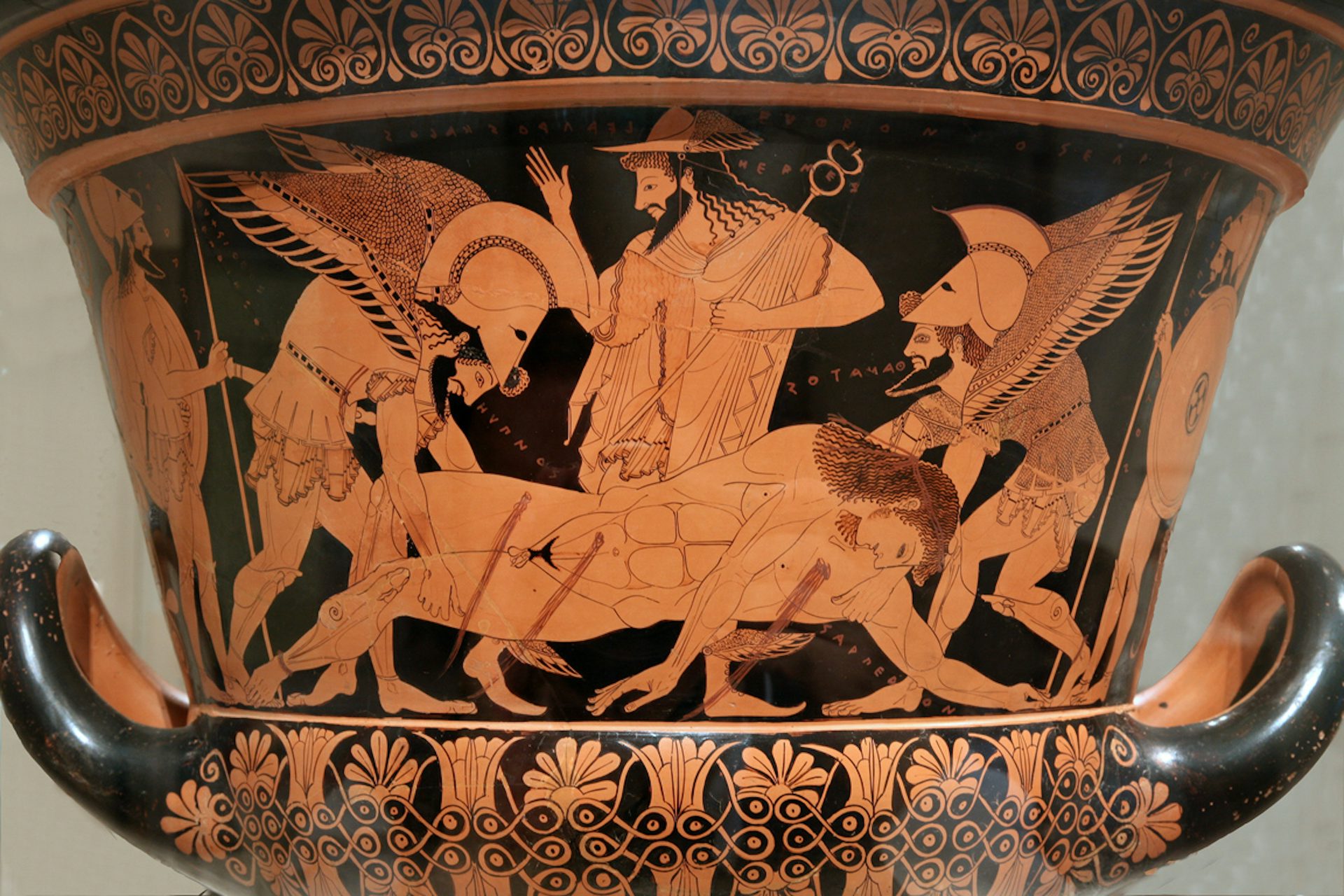
The so-called “Euphronios Krater,” an Attic red-figure calyx-krater signed by Euxitheos (potter) and Euphronios (painter) showing Hypnos (left) and Thanatos (right) carrying away the body of Sarpedon (center bottom) as Hermes (center top) presides
National Museum, Cerveteri / Jaime Ardiles-ArcePublic DomainThough the Iliad was continually tweaked and revised throughout antiquity, most modern scholars agree that the text we read today represents the Iliad as it was originally composed. The only exception is Book 10 (sometimes called the “Doloneia”), which appears to have been added to the poem at a later date.
Themes
The Iliad is a complex literary work that explores various themes: fate, war, glory, power, mortality, the role of the gods, and many others. But at its core, the Iliad is perhaps above all an epic about military glory (kleos) and what it means to be a hero. For Achilles, the protagonist of the Iliad, the choice to earn kleos is also the choice to die young:
For my mother the goddess, silver-footed Thetis, telleth me that twofold fates are bearing me toward the doom of death: if I abide here and war about the city of the Trojans, then lost is my home-return, but my renown shall be imperishable; but if I return home to my dear native land, lost then is my glorious renown [Greek: kleos aphthiton], yet shall my life long endure, neither shall the doom of death come soon upon me.[4]
To earn kleos—to be a hero—thus means acceptance of one’s fate, what the Greeks called kēr (“doom”) or moira (“allotment”). In Homer’s world, everything has been preordained. We constantly hear about prophecies and about the will of the gods. This is clear from the very first lines of the poem, where we are introduced to the wrath of Achilles—the subject of the Iliad, and of course another important theme—and to the way its course is directed by Zeus himself, the most powerful of the gods:
The wrath sing, goddess, of Peleus’ son, Achilles, that destructive wrath which brought countless woes upon the Achaeans, and sent forth to Hades many valiant souls of heroes, and made them themselves spoil for dogs and every bird; thus the plan of Zeus came to fulfillment, from the time when first they parted in strife Atreus’ son, king of men, and brilliant Achilles.[5]
But fate also holds the gods in its dreadful power. Even Zeus cannot stand against fate: thus, in Book 16 of the Iliad, Zeus knows that his son Sarpedon is fated to be killed by Patroclus, but knows also that there is nothing he can do about it and that he must allow him to be killed.[6]
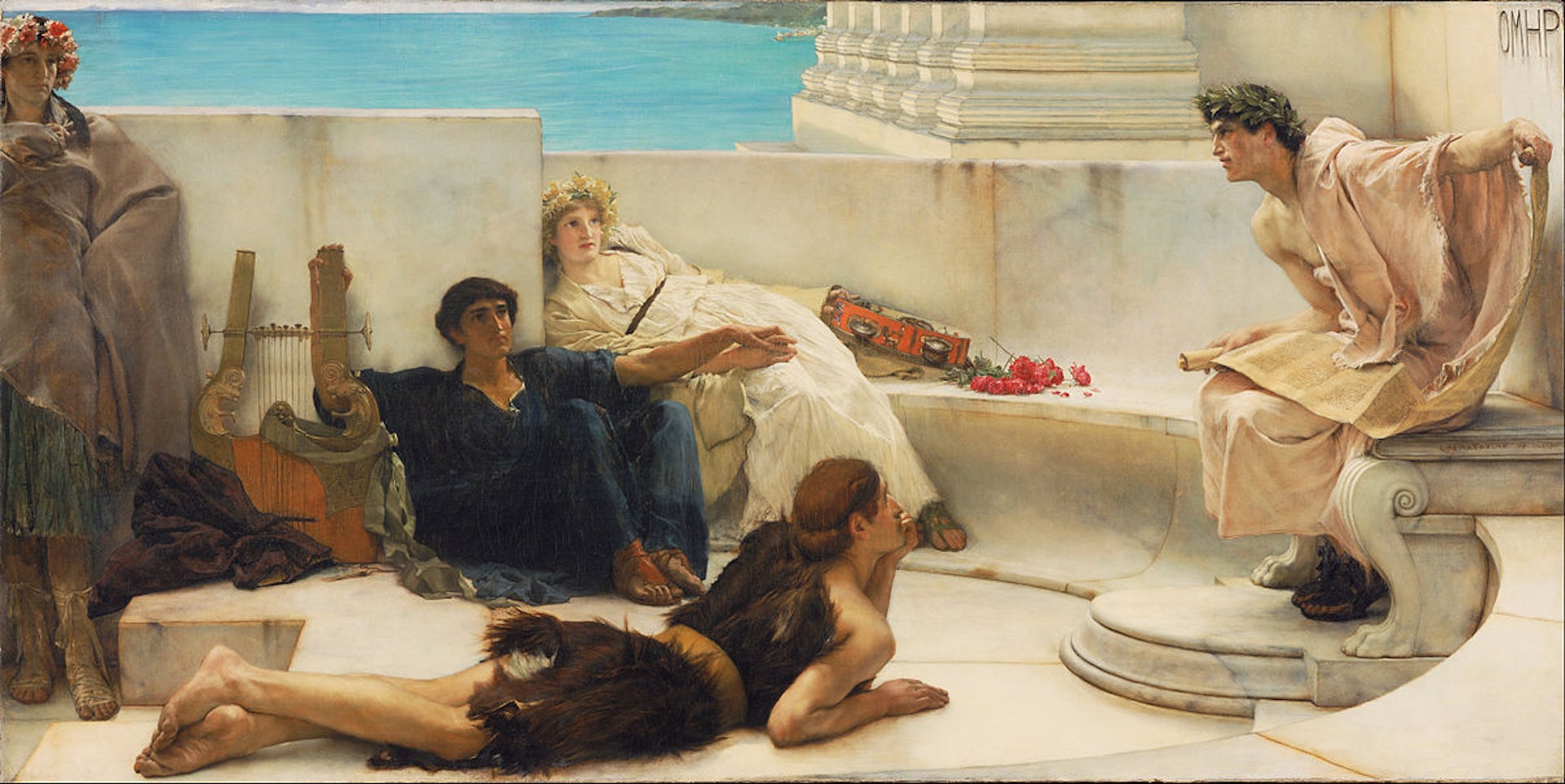
A Reading from Homer by Lawrence Alma-Tadema (1885)
Philadelphia Museum of Art, Philadelphia, PAPublic DomainBut glory, heroism, and fate are only part of the many aspects of life explored in the Iliad. The gods, of course, play an important role in the epic, as they did in the everyday life of the ancient Greeks: it is the gods—immortal and vastly wiser and more powerful than lowly mortals—who guide the action of the epic, intervening in human affairs, sending omens, and even influencing mortals’ mental processes.
Yet what really interests Homer is mortals and mortal life. The Iliad, indeed, is not only a war epic. It deals with all aspects of human life, from councils and debates to domestic life to ritual (just like the similarly variegated scenes depicted on the shield of Achilles, described in Book 18). In one touching scene from Book 6, Hector speaks with his wife and son and we glimpse the hero’s conflicting obligations to his city and to his family: Hector has no choice but to fight for Troy, even though that means he must risk leaving his wife widowed and his son orphaned.
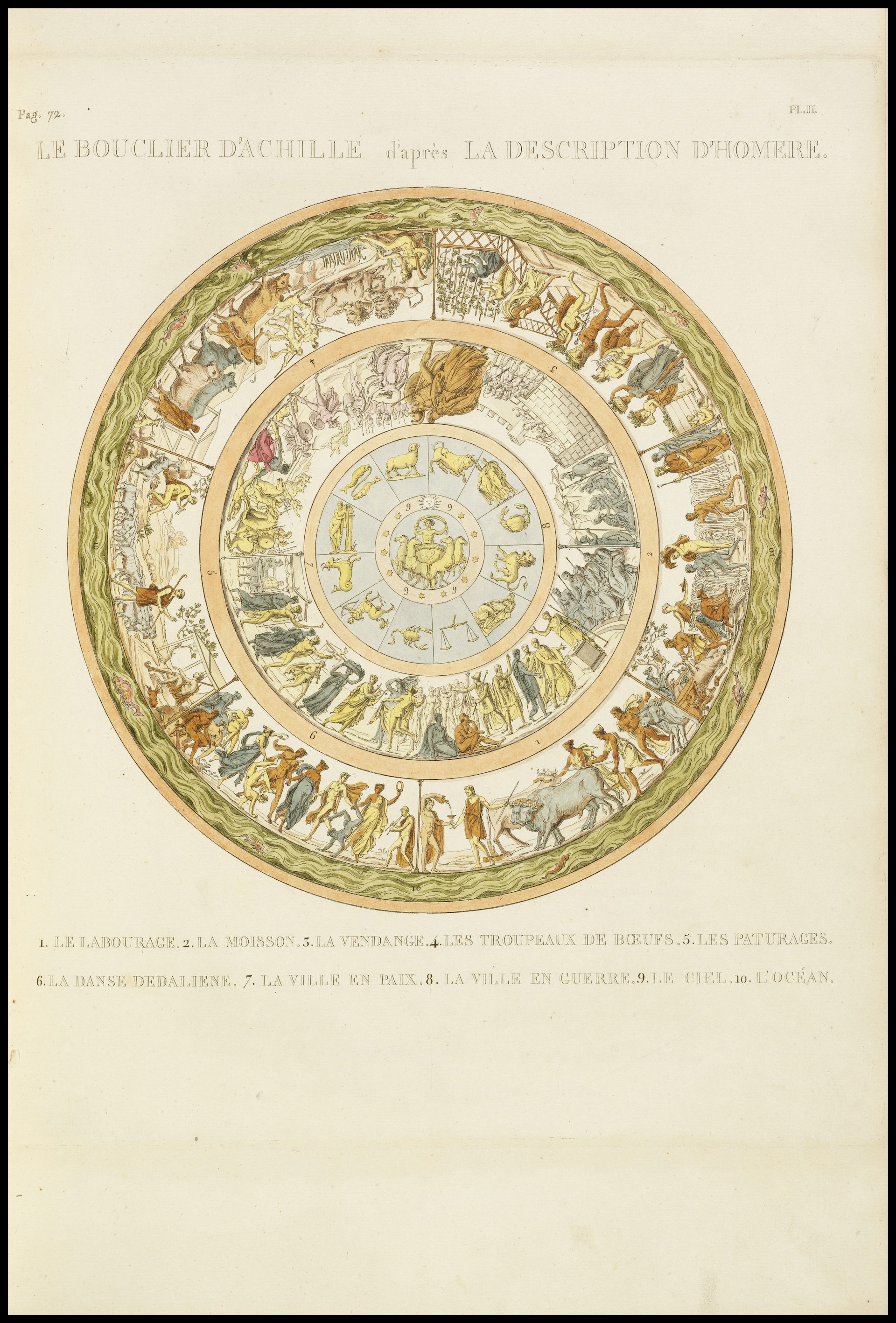
Hand-colored etching of the shield of Achilles according to the description of Homer by Antoine-Chrysostome Quatremère de Quincy (1814)
Wikimedia CommonsPublic DomainIn his engagement with these important themes, Homer is never simplistic. It is true that the Iliad embraces the old-fashioned aristocratic ideals of military glory and the beautiful death. But at the same time, Homer never loses sight of the destructive aspects of war, the capriciousness of the gods, or the flawed nature of human beings.
Reception
Antiquity
The impact of Homer’s poems cannot be overestimated. The Iliad and the Odyssey were regarded as the foundation of Greek cultural and religious identity virtually since their inception, and they exerted a huge influence on the Romans as well. They became the basis for all subsequent hexameter and elegiac poetry; all ancient epics, from Apollonius of Rhodes’ Argonautica to Virgil’s Aeneid to Nonnus’ Dionysiaca, were in some way a response to Homer; Homer was central in the development of ancient drama, with Aeschylus reportedly describing his tragedies as “crumbs from Homer’s feast”[7] and many called him the father of tragedy.
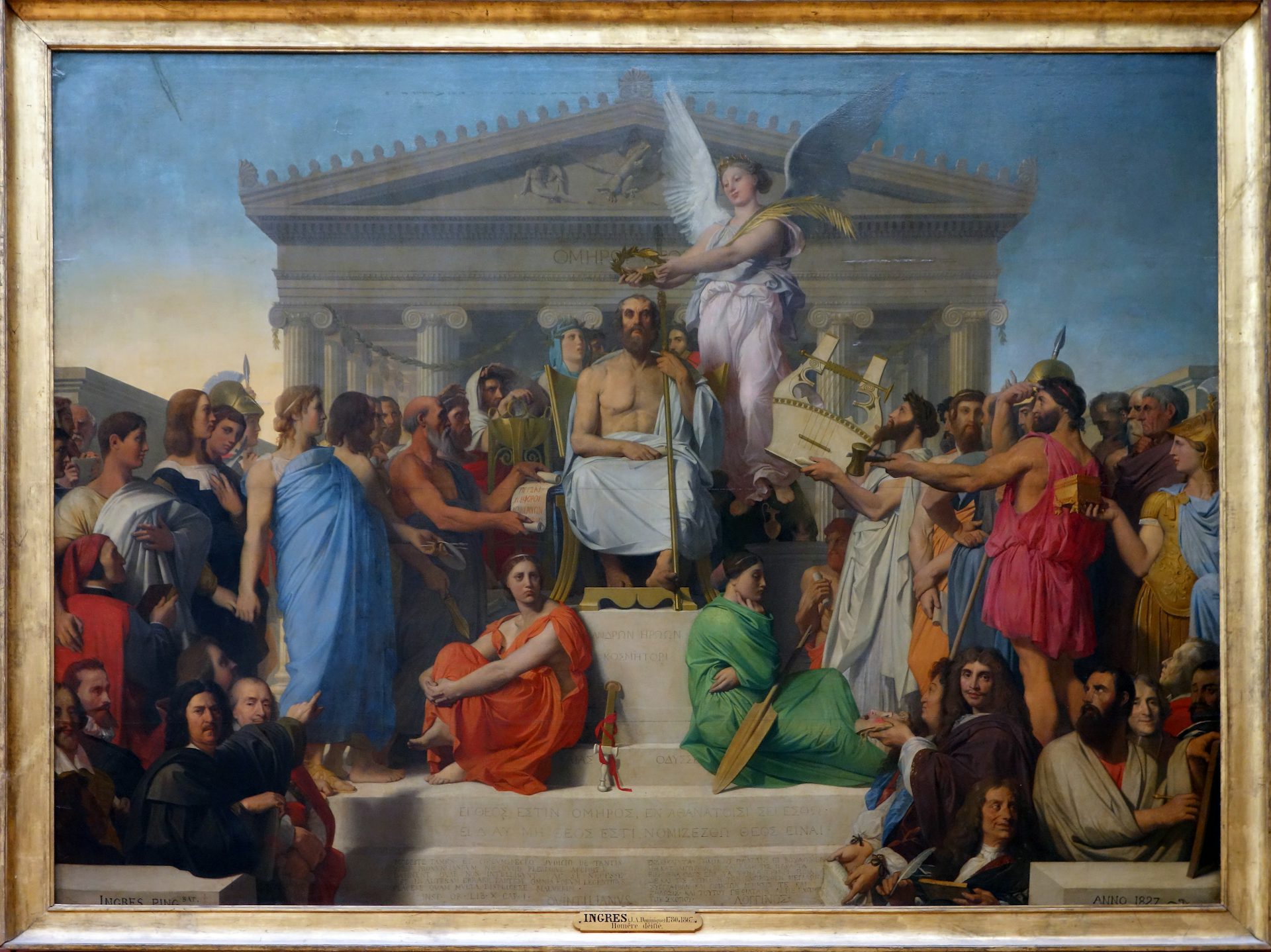
The Apotheosis of Homer by Jean-Auguste-Dominique Ingres (1827)
Louvre Museum, Paris / Steven ZuckerCC BY-NC-SA 2.0Medieval, Renaissance, and Early Modern Europe
During the Middle Ages and Renaissance, the Iliad and the Odyssey immediately became the heart of the literary and artistic “canon.” Numerous translations and adaptations of the Iliad were produced during this period. Some notable examples include Benoît de Sainte-Maure’s Romance of Troy (1160), Guido delle Colonne’s History of the Destruction of Troy (1287), and Raoul Lefèvre’s Recoeil des histoires de Troyes (ca. 1460, translated into English in 1473 by William Caxton as the Recuyell of the Historyes of Troye).
In the early modern period, the Iliad influenced important authors such as Christopher Marlowe (whose Doctor Faustus gives us the image of Helen as “the face that launched a thousand ships”) and William Shakespeare (especially in Troilus and Cressida). In fact, the tale of Troy became so popular in Europe that many nobles traced their ancestry to the heroes of the Iliad.
(FIGURE 16) The Iliad also captured the imagination of countless artists. Scenes from the Iliad were extremely popular subjects for Greek and Roman artists and have continued to provide fodder for painters, sculptors, and craftsmen throughout history, from the manuscript illuminators of the Middle Ages to Jacques-Louis David, Jean-Auguste-Dominique Ingres, William Theed the Elder, and many more.
Pop Culture
The Iliad remains also highly prominent in modern pop culture. It has inspired poetry by Robert Browning and Simone Weil, operas by John Treville Latouche and Sir Michael Tippett, novels by Christa Wolf, Madeline Miller, and Colleen McCullough, and a graphic novel series by Eric Shanower. It has been adapted into numerous films, miniseries, and TV shows, among them the 1956 film Helen of Troy and the 2004 film Troy, the 2003 miniseries Helen of Troy, and, most recently, the 2018 miniseries Troy: Fall of a City. Some adaptations, such as Dan Simmons’ science fiction novel Ilium (2003), are quite surprising, but only serve to illustrate how deeply Homer’s epic has pervaded our world.
Translations
There have been numerous English translations of Homer’s Iliad, many of them from hundreds of years ago. The following is a selected, chronological list of important and useful translations:
Pope, Alexander, trans. The Iliad of Homer. London: Bowyer, 1715. A fluid translation of the Iliad in rhyming couplets. Still popular today, though known to contain many artistic liberties and inaccuracies.
Butler, Samuel, trans. The Iliad of Homer. London: Longmans, Green, and Co., 1898. An old prose translation of the Iliad, still widely known and used.
Murray, A. T., trans. Homer: Iliad. 2 vols (Loeb Classical Library 170–171). Cambridge, MA: Harvard University Press, 1924. An old-fashioned, literal translation; useful, but not the most readable. Revised by W. F. Wyatt and reprinted in 1999.
Lattimore, Richmond, trans. The Iliad of Homer. Chicago: University of Chicago Press, 1951. Verse translation using a meter very close to Homer’s original dactylic hexameter. Still highly regarded and very true to the original. Reprinted in 2001.
Fitzgerald, Robert, trans. The Iliad. New York: Anchor, 1975. An elegant, literary translation in blank verse. Popular, but with some creative liberties. Reprinted by Farrar, Straus, and Giroux in 2004.
Hammond, Martin, trans. Homer: The Iliad: A New Prose Translation. London: Penguin, 1987. Clear, accurate prose translation.
Fagles, Robert, trans. Homer: Iliad. New York: Viking, 1990. Very modern, readable, and fast-paced verse translation. Very popular with general readers and undergraduates.
Lombardo, Stanley, trans. The Iliad (Hackett Classics). Indianapolis, IN: Hackett, 1997. Verse translation, accurate but very accessible.
Merrill, Rodney, trans. Homer: The Iliad. Ann Arbor, MI: University of Michigan Press, 2007. Musical translation written in dactylic hexameter, the same verse employed by the original.
Powell, Barry, trans. Homer: The Iliad. Oxford: Oxford University Press, 2014. Accurate verse translation, regarded as somewhat prosaic at times.
Alexander, Caroline, trans. The Iliad. New York: Ecco, 2015. Well-received verse translation. The first English translation of the Iliad completed by a woman.
Green, Peter, trans. The Iliad. Berkeley: University of California Press, 2015. Lively, often colloquial translation that remains accurate to the original.